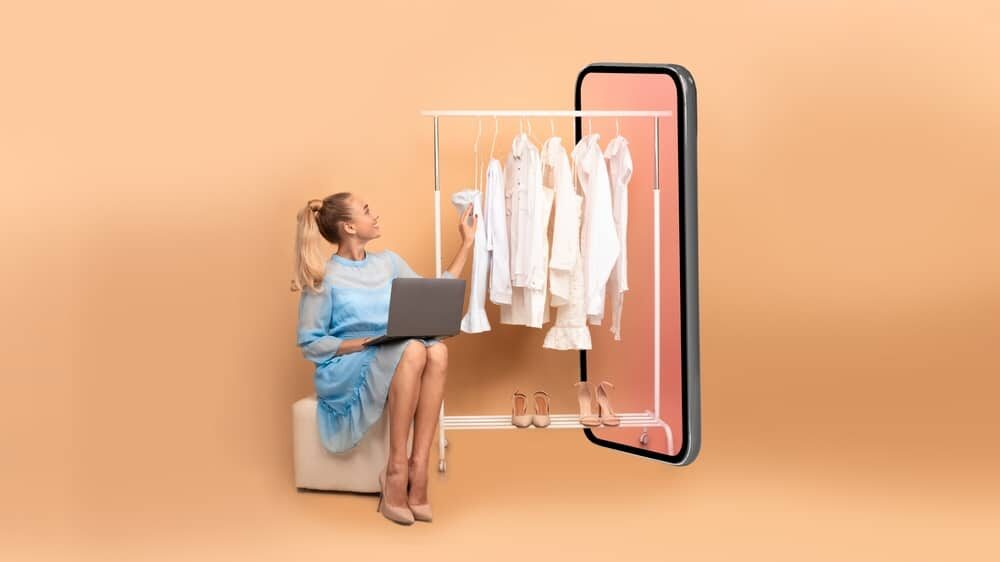
6 Fashion eCommerce Trends You Need to Know About
- etaily Team
- June 8, 2023
- 5 minutes reading
The fashion industry is known for its rapid changes, and in today’s competitive business world, companies must stay up-to-date on the latest trends. Although in-person retail and fashion eCommerce share some similarities, they differ significantly.
In-person retail means going to a physical store to browse and purchase products traditionallys before online shopping took over. In contrast, fashion eCommerce is the buying and selling of fashion products and services online through digital platforms.
There are many strategies companies can leverage to keep ahead of the competition in the digital space. Read and learn more about the latest eCommerce trends in the fashion industry.
An Overview of the Fashion eCommerce Landscape
The fashion eCommerce market has been increasing over the past few years. According to an eMarketer report, it’s expected to contribute significantly to the projected $5.9 trillion global eCommerce market by 2023.
GlobalData also predicts that the Philippines’ eCommerce market will hit $10.3 billion by 2025, driven by the need to purchase groceries and electronics during the COVID-19 pandemic.
Some of today’s leading eCommerce market leaders include Lazada, Shopee, Zalora, and BeautyMNL. These platforms provide various products and services, from online marketplaces to personalized recommendations.
6 Fashion eCommerce Trends Shaping the Industry Today
From virtual try-on to social media shopping, the world of fashion eCommerce is evolving rapidly. This section will explore six key trends currently shaping the industry and transforming how retailers do business online.
1. Mobile Commerce
Mobile commerce or m-commerce, is an important trend in the fashion eCommerce industry. Forbes reports that mobile eCommerce sales will reach $415.93 by 2023, making up more than 6% of total eCommerce sales.
You should optimize your mobile website and app for a smooth buying experience as more people use smartphones for their day-to-day activities, including shopping. However, achieving this objective requires various optimizations, such as responsive design and mobile payment options.
2. Social Media Shopping
Social media shopping is another craze gaining popularity in the fashion eCommerce industry. With platforms like Facebook, Instagram, and TikTok offering shopping features, brands can sell their products directly to consumers through these channels. It’s called social commerce.
For the record, 54% of social media users look into products on social media before making a purchase. By integrating social media shopping into your eCommerce strategy, you can reach a more extensive audience and increase sales.
3. Augmented reality
Augmented reality (AR) revolutionizes the fashion eCommerce industry, particularly in virtual fitting rooms. By enabling shoppers to virtually try on clothing, you can take advantage of visual merchandising tactics, reduce the number of returns, and increase overall buyer satisfaction.
A study shows that 61% of shoppers prefer stores with AR experiences, and 71% would shop more often if AR technology were integrated into their shopping experience. This technology can enhance your business’ shopping experience and boost customer loyalty.
4. Sustainable Fashion
Sustainability is becoming increasingly important in the consumer landscape—and eCommerce is no exception. Audiences are becoming more conscious of the environmental impact of their purchases and are looking for organizations that prioritize green initiatives. In fact, 66% of buyers and 75% of millennials consider sustainability a factor when shopping.
This global shift in buying habits means that if you want to build authority and trust, you must adopt a greener approach when creating and packaging your products. Implement sustainability by using eco-friendly materials and partnering with like-minded suppliers to reduce carbon footprints.
Today’s most popular global eco-friendly fashion brands include Patagonia, Everlane, and Reformation.
5. Athleisure Fashion
An increasing number of individuals have developed a preference for working remotely from their homes since the pandemic. Since then, athleisure fashion gained popularity as consumers worldwide prioritized comfortable and versatile clothing.
The market for athleisure wear is expected to hit $257.1 billion by 2026, growing 6.7% each year since 2019. As an eCommerce retailer specializing in apparel, there’s an opportunity to tap into this trend by offering customers athleisure clothing that’s both stylish and functional.
6. Personalization and Customization
Another effective way to enhance the buyer’s experience and journey is through personalization. Providing a customized shopping experience that caters to the individual’s taste and style can make the shopping journey more enjoyable and memorable, leading to loyalty and repeat business from satisfied customers.
According to a study, 63% of holiday shoppers prefer companies that provide personalized shopping experiences. One way to achieve customization is by using data analytics to provide personalized product recommendations based on the customer’s previous purchases or browsing history. You can also utilize email campaigns for upselling related products.
With the right team and tools, you can significantly increase engagement and drive sales by analyzing the customer’s preferences.
The Future of Fashion eCommerce
Staying up-to-date with fashion eCommerce trends is crucial to remain competitive in the rapidly evolving industry. By implementing these strategies, you can provide a seamless and engaging experience for your direct-to-consumer brand.
As the fashion eCommerce industry continues to evolve, there will be many more tactics and opportunities for you to explore.
By partnering with a trusted partner like etaily, you can stay ahead of the competition and scale your business strategically.
Contact us today to learn more about how we can help your fashion brand thrive and grow!
etaily Team
etaily is an e-commerce enabler committed to helping emerging and established brands build their online store and presence. We provide end-to-end e-commerce solutions—from content creation to warehousing and fulfillment—to enable brands to meet their goals, whether that’s attracting customers, enabling online transactions, or delivering products.